The remote border of La Balsa, was nor more than a few crumbling buildings. Passport control was quick for Rami, but not for Gal, who was waiting in the sun, in the terrible heat. The friendly immigration office changed some money for us, not trying to reap us off, as opposed to the nearby shop.
Andy was right – the terrible road and killer slopes stayed behind the old wooden border gate, as if not allowed entering Peru. The unpaved road was smooth and the slopes not more than a perfect 5%.
 The old wooden border gate.
The old wooden border gate. A dead armadillo.
A dead armadillo.
A woman gave us a big bunch of bananas and would not accept money – “este no vale aqua”.
We spent our first night on a roof in a small village. Interesting that the house latrine, around the corner was locked! Why? It made life difficult for Gal.
We woke up to see the whole valley filled with clouds. Seeing the weather, we stayed in bed; seams like the whole village stayed late in bed.
We had a wet, muddy to San Ignacio, surrounded by banana and coffee plantations.
 Thanks for the bananas.
Thanks for the bananas. Taking a shower.
Taking a shower. A wet, muddy day...
A wet, muddy day... Banana & coffee, always together.
Banana & coffee, always together.Our first Peruvian town 28/11/08
We reached San Ignacio, a small town in the middle of a coffee growing area, one of many in Peru.
There was no water, nor electricity in town – a typical Peruvian town!
While unpacking we found out that Rami's waterproof (we wish) saddle cover was missing. Rami hitched a motorcycle back to where we came from, searching for it, but with no luck.
Later, the electricity and water returned, so we enjoyed watching films dubbed to Spanish.
Coffee
We’ve been cycling in ‘coffee land’ since South Mexico, drinking some fantastic black coffee (Turkish), especially in the mountains in Honduras and Nicaragua, but since Colombia, we’ve been drinking ONLY black coffee – no more yucky instant coffee with creamer (for now).
In the last 2 days, since entering Peru, we’ve been cycling through coffee plantations. We’ve been asking the locals about buying toasted ground coffee, but no, the locals sell the coffee beans to the big companies and they drink instant coffee.
We went to ‘the’ shop in San Ignacio, to change dollars. Talking with the owner, he drew a bag of black coffee and told us the factory is just at the edge of town. Why did we ask the money changer about coffee? Why do they change dollars in a shop which sells mattresses and electronics?
We went to the coffee factory and spent there over an hour, talking with the workers and tasting fantastic coffee (percolator – yes, even Rami admits the percolator coffee was good) the coffee was so good that they spoiled us with another pot and a bag of coffee for the road.
We stayed another day, resting and enjoying the happy, live atmosphere of this typical Peruvian town. The market was full of action and good food – finally, good food!
The town stayed awake till way beyond sunset, something rare in Latin America (except for Guatemala & Mexico). Till now the town went to sleep 5 minutes after sunset, a bit depressing.
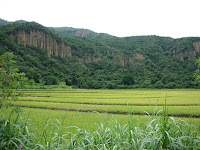 Rice fields. South-east Asia?
Rice fields. South-east Asia?

 No bridge yet.
No bridge yet. Paved!
Paved!Milton from Perico 30/11/08
Olga and Christian, cyclists whom we met in south Ecuador, told us about “Milton from Perico, a basic casa de ciclistas (cyclist house)… you need to go to the river to wash the dishes”.
We reached the tiny village of Perico around 16:00, quite early to stop, but all the bored locals, sitting near the highway (highway – we just left the unpaved part…), called us: “go to Milton”. So, we went to visit Milton.
We took a small, unpaved alley towards his house, a small farm, 1.5km away. We met him on the way, recognizing the XT components on his mountain bikes. He was very welcoming and sent us to his house; his wife will make us feel at home.
We had a fantastic evening with Milton and his wife. We cooked dinner on a firewood stove, while candles lit the room and drank Peruvian wine.
There was only one problem: washing the dishes. There were no running water in the house, we were used to that. What bothered us was that the small canal near the house was blocked for a few days now, due top the rains and no one did anything about it. The guy had XT shifters!
Jaen 01/12/08
The next day we arrived to Jaen, to the welcoming “El ciclista” bicycle shop. We were invited to stay. We cooked Chinese style dinner, which the extended family enjoyed. We naively brought 3 bottles of beer: one for Gal, one for Rami and one for whomever. Gal was waiting too long for her cold beer, after a long, hot day. But instead of actually drinking our beer, we were forced into the local custom: you don’t drink beer alone, you share in terms; one guy drinks a glass of YOUR beer, then passes the glass to the next guy, who drink a glass of YOUR beer and on, and on, till you finally get a chance to drink a glass of YOUR beer. In 20 minutes there wasn’t any beer left and we barely drank beer! Why not open a few bottles simultaneously?!? And yes, Gal likes to drink HER beer from the bottle!
We enjoyed the lively atmosphere, till Gal had an annoying, typical Peruvian experience: while considering whether to buy a cheap or expensive (with cloves) cigarette pack, the owner said: “You have money, Gringo, take the expensive one”.
We were forced to stay another day, due to the slow working pace of the mechanic. This will be a good opurtunity to recommend NOT using the local mechanic facilities, especially if you are on our way to Trujillo (Lucho, casa de ciclista, a good mechanic).
Learning from our mistakes, we enjoyed drinking OUR beers outside.
Later, we cooked dinner together with the warm family (the obnoxious sister was not there) and had a fantastic evening.
 El ciclista, Jaen.
El ciclista, Jaen.03/12/25
We were on our way to the Amazonas, the Salva Seca (the dry jungle).
Leaving Jaen, we met a Swiss couple, cycling north. They were tiered of Peru, after 2.5 months; as the husband said:”80% of them are good people, but it is not enough for cycling!”. Unfortunately, with time, we accepted this statement. He also mentioned kids throwing rocks at them, something that will happen to us too.
We continued cycling, in a dry valley, along a huge river. We spent the night in Bagua Grande, a typical modern (far from modern, but not colonial) Peruvian town, enjoying the dry desert climate & atmosphere, drinking cold beer. We stayed in a new hotel, everything clean, organized and… working, hmm, a nice surprise. The owner was very friendly and invited us for breakfast.
 Washing the mototaxi in the river, under the bridge.
Washing the mototaxi in the river, under the bridge. More mototaxis.
More mototaxis.
 Amazonas province.
Amazonas province.The next day we cycled to Pedro Ruiz (what a fantastic Spanish name!), on a perfect newly paved road, through an incredible gorge. It started in a desert valley, slowly closing on us and becoming greener and then climaxed in a narrow passage, with 500m jungle cliffs, which opened to high altitude grasslands. Green parrots were accompanying us, shouting in their high pitched voice.
 straight ahead...
straight ahead...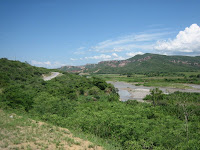 The river.
The river. Entering the canyon.
Entering the canyon.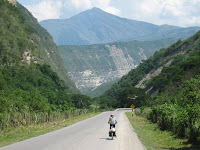 In the canyon.
In the canyon.


 A bit claustrophobic for a house...
A bit claustrophobic for a house...




 The gorge opens up.
The gorge opens up.

The next morning we woke up at 03:15 and set off an hour before sunrise, to pass a section of the road under construction which is blocked between 07:00 to 14:00. We knew about it from fellow cyclists and motorcyclists. The poor Swiss couple knew about it, and arrived on time, to discover the hours have been changed on the previous day.

 First light.
First light. Funny hair.
Funny hair.
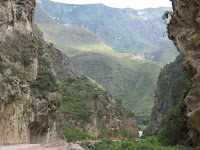


 A kitchen, filled with 'fresh' Cui.
A kitchen, filled with 'fresh' Cui.
 Resting, near a 'bridge'.
Resting, near a 'bridge'.Kuelap 06/12/08
Like all other few cyclists taking the eastern Ecuador-Peru border, we also stopped at the shit-hole, muddy village of Tingo and climbed to the ruins of Kuelap.
Nothing impressive, except for the amount of mud on the 1,200m climb.
The paste in which we climbed was quite remarkable, after all we have only been cycling in the last 2 years, till Gal realized that our altimeter was in units of feel, not in meters ;-(
If not for the herd of beautiful Llamas, the whole visit would have been a waste of time.
 Climbing, by foot.
Climbing, by foot. The valley, from above.
The valley, from above. The ruins.
The ruins.
 Llamas!
Llamas!

 Going back home...
Going back home...07/12/08
Climbing and descending 1,200m with our bikes and luggage is easy. Climbing and descending 1,200m by foot, carrying only a bottle of water was devastating!
Though our whole body was aching (except for the few cycling muscles), we decided to leave this muddy shit-hole (second time we use this phrase!!!) and cycle on to Leymebamba, which turned out to be a charming old colonial town. We decided to rest there a day, relax our traumatic body.
We were surprised to find incredibly tasty Turkish coffee, home made, one of the best we had in Latin-America; extremely cheap as well ;-)
 Horse parking, off to the market.
Horse parking, off to the market.
 Down-town horse parking.
Down-town horse parking. A huge avocado.
A huge avocado. Colonial Leymebamba.
Colonial Leymebamba.The Marañon – a big river to cross 09/12/08
From Leymebamba we climbed 1,500m, on the best dirt road we ever had (better than many of the paved roads we had), and easily reached Abra Barro Negro pass, earning a stunning view of the deep-narrow valley of the Marañon river, and a 2,500m descend, in one of the worst dirt roads we ever had.
 Leymebamba from above.
Leymebamba from above.

 A motorcyclist...
A motorcyclist... He's taking our pictures!
He's taking our pictures! Again!
Again!
 Our best unpaved road!
Our best unpaved road! On our luggage, no shame?
On our luggage, no shame?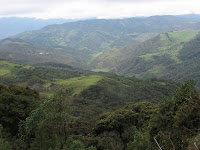
 Good location...
Good location...
Abra Barro Negro pass

 Wow!
Wow!
 Winter clothes.
Winter clothes. Ready to descend to the Marañon.
Ready to descend to the Marañon.

 Wow!
Wow! Where is the fear of height?
Where is the fear of height? 2,500m fall - made it!
2,500m fall - made it! The road, zigzagging.
The road, zigzagging. The Marañon, sparkling.
The Marañon, sparkling.

Our stove – part I
After descending about 1,000m, we stopped to camp at a road-workers camp. They immediately offered us a room and started sweeping it, lifting a cloud of dust.
We started working on dinner, as always, but our gasoline stove (MSR Whisperlite International) refused to work; gasoline didn’t go out and accumulate to the “cup”. Rami started cleaning it, again, a common procedure in the last few months, since Colombia. He saw that the Cable was filthy, but worse, it was ‘untwisted’ badly and refused to go back in all the way.
We fought with the stove for over 2 hours, till we finally got it to work, mas o menos… in the Latin-America atmosphere, as Gal mentioned.
We understood that our beloved stove (that has entered our prestigious hall of fame: Tool of the Month) is throwing his last balls of fire. The situation was more stressful than sad; it is very problematic for cycle-tourists to travel without a stove. During the last year we’ve been using it twice a day: coffee in the morning, a necessity for Gal, and cooking dinner. It dramatically reduces expenses and enriches our diet, from the boring plate of white rice and a chunk of chewy meat. Cycle-tourists were shocked of the size of our pots (and yes, the size of you pot does matter!) and of the pork ribs in honey and ginger we cooked in them.
We met cycle-tourists who’ve lost their stove and ate bread 3 times a day.
We needed a new stove…
To be continued…
The next morning we slowly descended the last 1,600m, crossing the impressive Marañon, at an altitude of 1,000m. The heat was unbearable; we started the slow 2,000m climb.
That night, after asking around, a family offered us an empty house (a 2 story colonial house) to sleep in.


 A spider.
A spider.

 Looking at the 2,000m climb, in front of us.
Looking at the 2,000m climb, in front of us.
 Brave Gal, still going down.
Brave Gal, still going down.



 Down... the Marañon... and up!
Down... the Marañon... and up!
 Starting to climb.
Starting to climb.The next day we accomplished the climb, to 3,250m. Rami was feeling sick the whole day and even threw-up, but we managed to reach Celendin, the ’big’ city.
 Looking back.
Looking back.
 Mangos!
Mangos! A few more serpentines to go.
A few more serpentines to go. A few less...
A few less... Rami, throwing up.
Rami, throwing up. What a view for throwing up!
What a view for throwing up!
 Celendin.
Celendin. Back to the sierra.
Back to the sierra.Our stove – part II 11/12/08
We quickly went to an internet café – finally internet!
We were shooting at all directions: we checked with REI, with MSR, with shops in Huaraz (the center of Peru mountaineering), with Yariv from San Francisco (our main purchaser in the USA), with Jim from San Diego (if Yariv was too busy with the pregnancy of the twins… as if he was pregnant and not Christa ;-), with Rachel, Rami's mom in Israel, our deputy director of operations, forums of Israeli travelers is S.A. and The Thorn Tree, the fantastic forum of Lonely Planet.
Tired and restless, we returned to our hotel room, which didn’t have a window, but had a TV. We saw a few movies – our therapy.
The next morning we went straight to the internet. The Peruvian shops didn’t have the stove (some had it for rent, not for sale). REI can’t send MSR equipment at all (interesting…). Yariv emailed, asking how he can help, so we called him, forgetting the different time zone (did we go so much “east”? This trip was supposed to be “south”), waking him early. We said we’ll call later, oops.
A bit later we called Jim, who was happy to help, so this time Yariv was off the hook with our REI requests.
We were scared of shipping a stove from the USA: if there will be a problem, what can we do? Better try the Peru distributor.
We went back to the hotel and asked the owner to help us with his Spanish, we want to call the MSR distributor in Lima, again, but, this time we hope to understand him.
No – they cannot ship the stove across the country…
We asked his help for another phone call: Maybe a friend in Trujillo, Lucho, from the famous Casa de Ciclista, can get someone in Lima to buy the stove and send it over (he does that with bicycle parts). We will reach Trujillo, 3-5 cycling days away.
Ichar, the owner's nephew, suggested the help of his brother, who lives in Lima. He will buy the stove and sent it to Cajamarca, 2 cycling days away, thus we’ll not need to leave the mountains.
We decided to go for it; we didn’t want to leave the mountains. We wanted to take the small mountain route, between Cajamarca and the Cordillera Blanca (yes – there is a road!). What could we loose? $100 and a few nerve-tearing days of anticipation.
Ichar talked with his brother, we went to the bank and deposited $100, and waited.
In the afternoon we were told that the brother bought the stove and will send it tomorrow by “Civa” (a bus company) to their office at Cajamarca.
We were ready to go!
 Ichar and Carol - thanks!
Ichar and Carol - thanks!The 2 days to Cajamarca were relaxed, with tiny villages and Sunday markets.
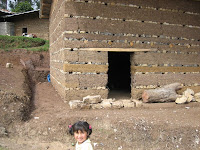 Adobe houses.
Adobe houses. Weaving.
Weaving. Full moon; early morning.
Full moon; early morning.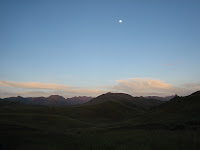

 Very typical - carrying a radio.
Very typical - carrying a radio.
 A Sunday market, on the way.
A Sunday market, on the way.Our stove – part III 14/12/08
We entered Cajamarca and cycled directly to the Civa bus terminal. Rami entered and 3 minutes later was out, with our new MSR Whisperlite International gasoline (and kerosene) stove.
Who would ever imagine that such a complex operation, spanning over 3 cities, will turn out successful, in a country like Peru?
We recalled Ichar's words, hoping people will help him when he will need it, especially in a foreign country.
 Our new stove, at 'Civa'.
Our new stove, at 'Civa'.Ceviche 15/12/08
We rested a day in Cajamarca, relaxed, the stove episode behind us.
In the morning we went to the market, in search of food. We saw many people in one of the food stalls. We were surprised to see they were eating some kind of a huge seafood dish. We ordered our first of many Ceviche dishes, the mixto – delicious!
 Leaving Cajamarca.
Leaving Cajamarca.Colonial villages 16/12/08
In the next 3 days, from Cajamarca to Huamachuco, we road through typical sierra scenery, (boring), dotted with beautiful colonial villages.
In the beautiful village of Cajabamba Rami surprised Gal with a beautiful hotel room, in an old 2 story adobe colonial house. It had a wooden floor and large windows – 2 of them (after the last hotel rooms with no windows at all)!
This area of Peru was the peak of colonial villages in our trip.
 Rocky III - they love him!
Rocky III - they love him!




A decision from above – to Trujillo 20/12/08
After a day's rest in Huamachuco, with its ridiculously huge plaza and it's live market (We loved how the woman shouting:”Si, hay Cebiche!”), we were ready to attack the terrible mountain dirt road directly to the Cordillera Blanca. We were all packed, ready to leave the hotel, when Rami noticed that his rear tire is falling apart. After 11,000km, many of them on terrible roads, and ZERO flats (!), his beloved Specialized Armadillo Crossroads tire was dying. Rami found it much better than the Schwalbe Marathon XR.
Without hesitation, we called Lucho, informed him of our problem and our arrival, and headed to Trujillo, down to the coast.
The following 2 days taught us it was not only downhill! We expected a short climb and then a long descend, as the locals told us (they were probably never out of Huamachuco), but found ourselves a day & a half over 4,000m, in the cold grasslands of the Paramo. We saw many llamas and Alpacas and spent a night in a house, sleeping under a big chunk of goat (no need of a fridge here)
 Hat meeting.
Hat meeting. The Paramo.
The Paramo.
 Llamas!
Llamas! Our house for the night, with the chunk of meat.
Our house for the night, with the chunk of meat.

Llamas!

We enjoyed a 3,600m descend, half of it paved. The scenery would have been spectacular, 4,000m cliffs with desert colors, if not for the bad visibility.
 A strange shit-hole on the way.
A strange shit-hole on the way. Difficult to describe.
Difficult to describe.
Between 2,000m-1,000m was pineapple land, with pineapple fields all around us. We were invited for one and got another one for the way.

 Pineapples!
Pineapples!The last 30km, flat, till Trujillo, were terrible. We encountered, for the first time, the notorious Pacific winds of South-America. We were fighting to reach 10 km/h.
We had to pass quickly a bad neighborhood, in the outskirts of Trujillo; but the wind… 8 km/h…

Trujillo 22/12/08
We were excited about entering our first big city (population over 800,000), the third biggest in Peru.
The eastern entrance was like a dump yard… we tried finding a path through the plastic bags, flying in the wind). We couldn’t believe the locals, telling us that this is the way (the way to rob us…). We continued 2 blocks and… we were in the city… if you can call it a city (wait till we write about Chimbote…).
We reached the main plaza, parked there and enjoyed our achievement – arriving to a main plaza of a big city always fills you with a feeling of triumph.
A couple approached us, Alvaro & Jacquline, cyclists from Canada, on their way to Chile, to their wedding. We all went to Lucho’s Casa de Ciclistas, a few blocks away.
We stayed at Luchos 5 days, much more than we planned. We mostly wasted our time going to the nearby market, eating Ceviche and cakes (cakes?) and cooking with the Canadians and Jacque, the weird-interesting French-Canadian, on 3 MSR stoves.
We spent Christmas Eve with the family, in their new home. Again, we found it strange that the Peruvians eat restaurant grilled chicken on all their holidays. Lucho was late; everybody was upset. But, then he pulled out from his magic hat the gifts he bought, exactly what everybody wanted/needed. Gal got 2 pairs of socks – how did he know that her 2 year old socks are rotting? After teasing his daughter, he gave her the sunglasses she wanted, perfect on her.
Lucho worked on our bikes. We felt very secure in his loving hands; we just had to keep an eye, see that he doesn’t fall asleep.
As for Rami’s tire: by luck, Jacque, who flew in from Canada, brought 2 Schwalbe Marathon XR 26*2.0, just what the doctor ordered. Funny, it was easier finding them in shit-hole Trujillo than in the USA! We replaced both our rear tires, after 11,345km with no flats.
 Lucho.
Lucho. Rami's dead tire.
Rami's dead tire. Cooking, in the Casa de Ciclistas.
Cooking, in the Casa de Ciclistas.Huanchaco – Huanchaco – Huanchaco! 26/12/08
For months (years), Rami has been telling Gal about Yossi’s dream, of being a ‘bus public relations guy’ (shouting the destination of the bus), if he was not a Director Product Manager of a very successful High-Tec company, and if so, so where else if not “Huanchaco – Huanchaco – Huanchaco!”
Rami especially waited for a bus that will fulfill our expectations…
It was the first place we reached, after a month in Peru, , that Rami had visited 12 years ago, while traveling with Yossi after their military service. Funny, how traveling with bicycles is different…
As apposed to the last time, we had a sunny, beautiful day. It was a tourist town/beach, but, yet, pleasant. We missed being in the beach, drinking beer and falling asleep on the sand.
Huanchaco – Huanchaco – Huanchaco!
 The beach.
The beach. Is there anything more Israeli?
Is there anything more Israeli? Woke up, need to go... but a picture.
Woke up, need to go... but a picture. A knife sharpener.
A knife sharpener.We’d like to thanks Lucho. Though being 2 of thousands of cyclists, who’ve stayed at his house in over 10 years of hosting, he treated us like the first!
 With Lucho, Alvaro & Jacquline.
With Lucho, Alvaro & Jacquline.That night we took a bus (don’t tell anyone) to Huaraz and our Cordillera Blanca tour.

No comments:
Post a Comment